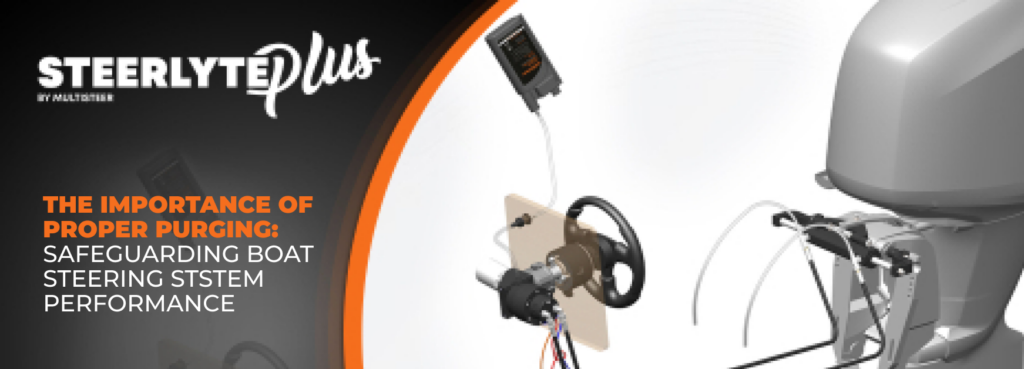The hydraulic steering system plays a vital role in the safe and efficient operation of boats. It ensures smooth maneuverability and responsive control, contributing to a pleasurable and secure boating experience. However, one aspect that is often overlooked or incorrectly performed is the purging process. Multisteer Hydraulic Systems do require proper purging, check the details to understand the significance of proper purging, its impact on the performance of the Multisteer boat steering system, and the risks associated with incorrect purging.
Thank you for reading this post, don't forget to subscribe!
Understanding the Purging Process
Purging, also known as bleeding or venting, is the process of removing air from the hydraulic steering system. When air accumulates within the system, it can lead to numerous issues, including reduced responsiveness, increased steering effort, and compromised safety. Proper purging ensures that the system is filled with hydraulic fluid, free from air pockets, and ready for optimal performance.
Effects of Incorrect Purging
1. Reduced Steering Response: Air trapped in the hydraulic system can cause sponginess or delay in the response of the boat steering system. This delay poses a significant risk, especially during critical moments when quick and precise steering adjustments are necessary to avoid obstacles or navigate in challenging conditions.
2. Increased Steering Effort: Air pockets interfere with the smooth operation of the hydraulic steering systems, resulting in increased steering effort. This additional strain on the steering mechanism can fatigue the operator and make steering more challenging, leading to decreased control and potential accidents.
3. Potential System Damage: Air bubbles within the hydraulic steering system for outboards can cause localized pressure fluctuations, leading to cavitation and a phenomenon known as “steering wheel kickback.” These abrupt pressure changes can damage components such as the hydraulic pump, steering cylinder, or control valves, resulting in costly repairs or even system failure.
Risks Associated with Incorrect Purging
1. Loss of Control: Insufficient purging can lead to erratic and unpredictable steering behavior. The presence of air pockets compromises the integrity of the boat steering systems, potentially resulting in loss of control and endangering the occupants of the boat as well as other vessels nearby.
2. Safety Hazards: In emergency situations where swift and accurate steering maneuvers are critical, an inadequately purged system may fail to respond promptly, increasing the risk of collision, grounding, or other hazardous incidents. Properly purging the system is crucial to ensure the safety of all on board.
3. Costly Repairs and Downtime: Neglecting the purging process can lead to premature wear and tear on steering components, ultimately necessitating expensive repairs or replacements. Moreover, prolonged use of a poorly purged system can cause damage that requires the boat to be out of commission for extended periods, affecting recreational plans or commercial operations.
Proper Purging Guidelines
To safeguard the performance of the boat steering system and mitigate potential risks, adhere to the following purging guidelines:
1. Follow Manufacturer Recommendations: Refer to the Multisteer boat’s manual or consult the manufacturer’s guidelines for specific purging instructions. Manufacturers often provide detailed step-by-step procedures tailored to their best hydraulic steering systems, ensuring optimal performance and longevity.
2. Two-Person Approach: In many cases, purging requires a two-person operation. One person should be stationed at the helm to manipulate the steering wheel, while the other is positioned at the hydraulic steering system to monitor fluid levels and release air through the bleeder valves.
3. Systematic Approach: Purge the boat steering kit in a systematic manner, starting from the lowermost points and working your way up. This approach allows air to escape efficiently, ensuring thorough purging and minimizing the likelihood of air pockets remaining in the system.
4. Verify Performance: After purging, test the steering system under controlled conditions to ensure a proper response, smooth operation, and absence of any abnormal noises or vibrations. If any issues persist, seek professional assistance to identify and resolve the problem promptly.
Conclusion
The purging process is a crucial aspect of maintaining the optimal performance and safety of a boat hydraulic steering system. Neglecting or incorrectly performing the purging procedure can lead to diminished steering response, increased effort, and potential system damage, loss of control, safety hazards, and costly repairs. By adhering to manufacturer guidelines and following proper purging techniques, boat owners can ensure the integrity of their steering systems, enabling a smooth and secure boating experience for all.
To Know More: https://shop.multisteer.com/
Follow our social media pages for more updates: Facebook | Instagram | Twitter | Linkedin | Youtube
#Multisteer #Hydraulicsteering #Boating #Marine #Power #Steerlyteplus #boatsteeringkit #powerassisted #hydraulic #steeringsystem #portugal #Australia #NewZealand #SaudiArabia #Indonesia #Nigeria #Italy #France #Spain #Russia #Norway #SouthAfrica #Philippines #Vietnam #Thailand #Singapore #Finland #Poland #UK #HongKong

